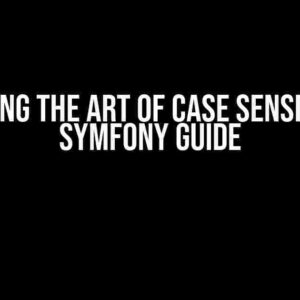Are you tired of encountering the infamous “unused-top-binds” warning in your Yesod/Haskell project? Do you find yourself scratching your head, wondering what’s going on behind the scenes? Fear not, dear reader, for today we embark on a thrilling adventure to demystify this enigmatic error and uncover the secrets of Haskell’s type system.
What is the “unused-top-binds” warning?
The “unused-top-binds” warning is a cryptic message that appears when the Haskell compiler (GHC) detects a potential issue with your code. Specifically, it occurs when a top-level binding (a definition or declaration) is not used anywhere in your program. This might seem harmless, but it can lead to performance issues, code bloat, and, in extreme cases, even runtime errors.
Why does this warning matter?
Ignoring this warning can result in several problems, including:
- Performance degradation: Unused top-level bindings can slow down your program, as the compiler generates unnecessary code.
- Code bloat: Unused bindings can lead to an increase in compiled code size, making your program larger and more difficult to maintain.
- Runtime errors: In rare cases, unused top-level bindings can cause runtime errors, especially when working with laziness and concurrency.
Causes of the “unused-top-binds” warning
There are several reasons why this warning might appear in your Yesod/Haskell project. Let’s explore some common culprits:
Unused imports
One of the most common causes of the “unused-top-binds” warning is importing modules or functions that are not used anywhere in your code. This can happen when you’re experimenting with different imports or when you’ve forgotten to remove unused imports.
import Data.Maybe (isJust) -- Unused import
Unused type synonyms
Type synonyms are a powerful feature in Haskell, but they can also lead to the “unused-top-binds” warning if not used correctly. Make sure you’re using your type synonyms somewhere in your code.
type MyType = Int -- Unused type synonym
Unused data constructors
Data constructors are essential in Haskell, but if you define a data constructor that’s not used anywhere, you’ll encounter the warning.
data MyData = MyConstructor -- Unused data constructor
Unused functions and variables
Unused functions and variables are another common cause of the warning. This can happen when you’ve defined a function or variable that’s not used anywhere in your code.
myUnusedFunction :: Int -> Int
myUnusedFunction x = x + 1
myUnusedVariable :: Int
myUnusedVariable = 42
Solving the “unused-top-binds” warning
Now that we’ve identified the possible causes, let’s dive into the solutions!
Remove unused imports
The first step is to remove any unused imports from your code. Go through your imports and eliminate any that are not used.
-- Remove unused imports
import Data.Maybe (isJust)
Use type synonyms correctly
Make sure you’re using your type synonyms somewhere in your code. If you’re not using them, consider removing them or redefining them to make them more useful.
type MyType = Int
myFunction :: MyType -> MyType
myFunction x = x + 1
Use data constructors correctly
Ensure that you’re using your data constructors somewhere in your code. If you’re not using them, consider removing them or redefining them to make them more useful.
data MyData = MyConstructor Int
myFunction :: MyData -> Int
myFunction (MyConstructor x) = x + 1
Remove unused functions and variables
Remove any unused functions and variables from your code. This will help declutter your codebase and avoid the “unused-top-binds” warning.
-- Remove unused functions and variables
myUnusedFunction :: Int -> Int
myUnusedFunction x = x + 1
myUnusedVariable :: Int
myUnusedVariable = 42
Best practices to avoid the “unused-top-binds” warning
To avoid the “unused-top-binds” warning in the future, follow these best practices:
- Keep your imports clean: Only import what you need, and avoid importing entire modules unless necessary.
- Use type synonyms wisely: Define type synonyms that make sense and use them consistently throughout your code.
- Define data constructors with care: Only define data constructors that are used somewhere in your code.
- Remove unused code: Regularly review your code and remove any unused functions, variables, or imports.
- Use GHC’s warning flags: Enable GHC’s warning flags, such as `-Wall`, to catch potential issues early on.
Conclusion
The “unused-top-binds” warning in Yesod/Haskell might seem mysterious at first, but with a clear understanding of its causes and solutions, you can avoid this warning and write more efficient, maintainable code.
| Cause | Solution |
|---|---|
| Unused imports | Remove unused imports |
| Unused type synonyms | Use type synonyms correctly |
| Unused data constructors | Use data constructors correctly |
| Unused functions and variables | Remove unused functions and variables |
By following the best practices outlined in this article, you’ll be well on your way to writing Haskell code that’s free from the “unused-top-binds” warning.
Additional resources
For further reading and exploration:
Happy coding, and may the Haskell force be with you!
Frequently Asked Question
Get the lowdown on the weird unused-top-binds warning in Yesod/Haskell and become a master of error-free coding!
What is this weird unused-top-binds warning in Yesod/Haskell and why is it haunting me?
This warning is raised when the type checker finds bindings at the top level that are not used anywhere in the code. It’s like having a secret ingredient in your recipe that you never actually use – it’s confusing and unnecessary! In Yesod, this warning typically appears when you have a definition that’s not being used in any of your handlers or widgets.
How do I fix this warning and make my code squeaky clean?
To fix this warning, simply remove the unused bindings or make sure they’re being used somewhere in your code. You can also use the `_` wildcard to ignore the binding if it’s not necessary. For example, if you have a function that returns a value you don’t need, you can use `_` like this: `let _ = myFunction` to silence the warning. Easy peasy!
Why does this warning only show up in my development environment and not in production?
This warning is typically only raised in the development environment because the `-Wall` flag is enabled by default. This flag tells GHC to be more strict and report all warnings, including the unused-top-binds warning. In production, this flag is usually disabled to avoid unnecessary warnings. So, if you’re seeing this warning in dev but not in prod, it’s because dev is being more vigilant about your code’s cleanliness!
Can I just ignore this warning and move on with my life?
Technically, yes, you can ignore this warning, but it’s not recommended. Unused bindings can lead to confusion and make your code harder to maintain. By fixing this warning, you’ll ensure that your code is more readable, efficient, and less prone to errors. Plus, it’s always a good idea to listen to the compiler’s warnings – it’s like having a personal coding coach!
How can I avoid getting this warning in the first place?
To avoid getting this warning, make sure to regularly clean up your code by removing any unused definitions or imports. You can also use tools like `hlint` to help identify unused bindings and other code smells. By being mindful of your code’s organization and maintainability, you’ll reduce the likelihood of getting this warning and keep your coding experience hassle-free!





